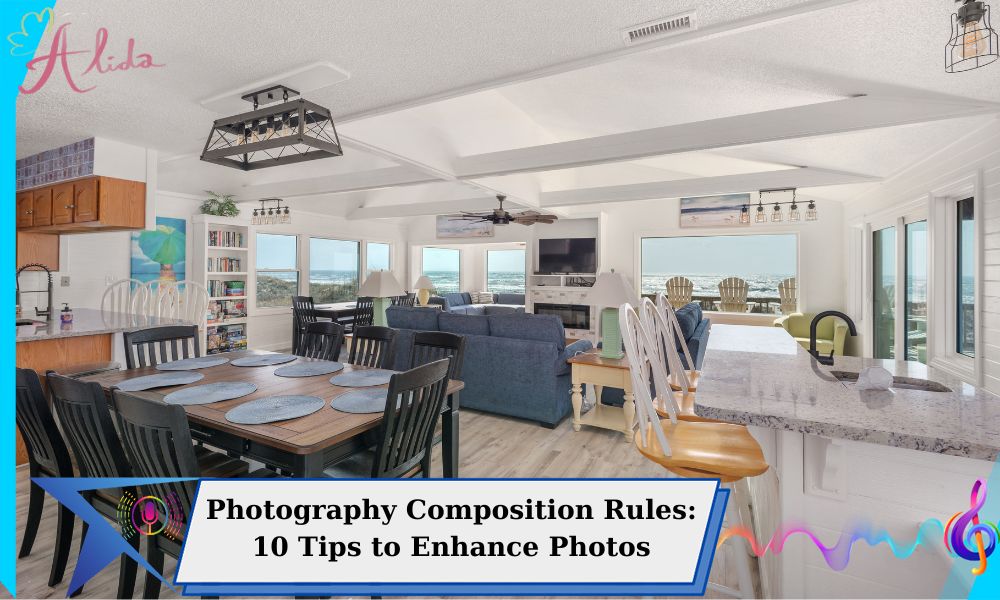Photography composition plays a crucial role in capturing visually compelling images. A well-composed photograph guides the viewer’s eye, evokes emotions, and enhances storytelling. Mastering composition techniques allows photographers to create dynamic and engaging visuals rather than just taking random shots.
Photography Composition Rules: Impact on Emotion & Visual Appeal
Composition influences how an image is perceived by manipulating elements such as balance, depth, and color. Effective composition can make a subject stand out, create harmony, or even convey tension. Whether in portrait, landscape, or real estate photography, applying photography composition rules helps produce aesthetically pleasing and impactful photos.
10 Photography Composition Rules for Better Shots
1. Rule of Thirds
One of the most fundamental photography composition rules, the rule of thirds divides an image into nine equal parts using two horizontal and two vertical lines. Placing key elements along these lines or at their intersections creates a balanced and naturally appealing composition.
2. Leading Lines
Leading lines direct the viewer’s eye through the image toward the main subject. They can be roads, fences, rivers, or even architectural elements. By using leading lines effectively, photographers can create depth and guide the audience’s focus.
3. Symmetry and Balance
Symmetry brings a sense of order and harmony to a photograph. A balanced composition, whether symmetrical or asymmetrical, ensures that no part of the image overpowers the rest. Utilizing reflections, architecture, and natural landscapes can help achieve symmetry.
4. Natural Framing
Using elements such as windows, arches, or tree branches to frame the subject enhances depth and context. This technique naturally draws the viewer’s attention toward the focal point, adding layers to the composition.
5. Negative Space
Negative space is the unoccupied area around the subject. This technique allows the subject to stand out, creating a minimalist and dramatic effect. Negative space can be particularly effective in portrait and product photography.
6. Photography Composition Rules: Angles & Perspective
Changing the shooting angle alters the perception of a subject. High angles can make a subject appear smaller or more vulnerable, while low angles can make it look dominant. Experimenting with different perspectives adds variety and uniqueness to compositions.
7. Depth of Field
Controlling depth of field helps separate the subject from the background. A shallow depth of field (achieved with a wide aperture) blurs the background, making the subject pop. A deep depth of field (using a narrow aperture) keeps everything sharp and is ideal for landscapes and real estate photography.
8. Color and Contrast
Colors impact the mood and visual appeal of an image. Using complementary colors enhances contrast, while monochromatic schemes create a minimalist aesthetic. Contrast, whether through colors or lighting, helps draw attention to key elements in the frame.
9. Rule of Odds
The rule of odds states that an odd number of subjects in a frame is more visually appealing than an even number. Odd-numbered compositions create a sense of balance and natural harmony, making the scene feel more dynamic.
10. Photography Composition Rules: Storytelling in Photos
Beyond technical rules, composition should contribute to storytelling. Every element within the frame should serve a purpose, whether it’s leading lines guiding the viewer or color tones setting the mood. Great composition transforms a simple photograph into a powerful narrative.
Photography Composition Rules: More Tips to Enhance Shots
- Practice and Observe: The more you shoot, the better your sense of composition becomes.
- Learn from Professionals: Analyze and study the work of experienced photographers.
- Experiment with Angles and Perspectives: Try unconventional compositions to develop a unique style.
Conclusion
Mastering photography composition rules is key to taking stunning and impactful photos. By applying the rule of thirds, leading lines, symmetry, and other techniques, photographers can transform ordinary shots into professional-quality images. The key is to practice, experiment, and refine your style. Start applying these composition techniques today and watch your photography improve!
At Alida, we specialize in high-quality real estate photo editing, helping photographers and realtors enhance their images for maximum impact. Whether you need HDR blending, sky replacements, or virtual staging, our expert editors ensure stunning results.








